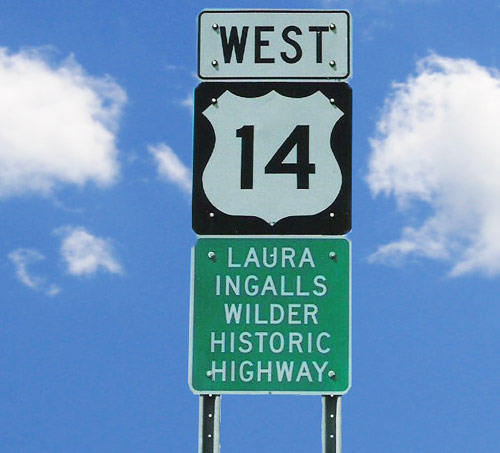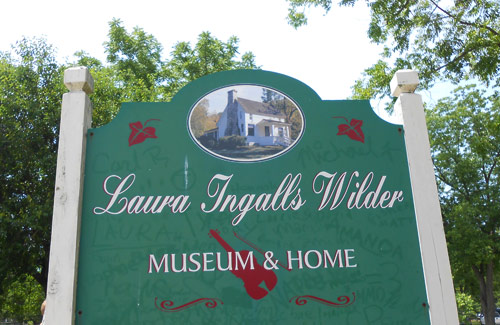En route to Mansfield, Missouri, Laura and Almanzo’s final home, we had time to think and talk about the places connected to Laura Ingalls Wilder and her family that weren’t on our Little Journey itinerary. Once we reached Mansfield, our mileage for the Little Journey would be more than a thousand miles, so there were some places along the Laura Ingalls Wilder Historic Highway we just couldn’t include, like:
- Burr Oak, Iowa, where the Ingalls family retreated following the grasshopper plague and crop failures to run the Masters Hotel with William and Mary Steadman, friends from Walnut Grove. The Ingalls didn’t stay in the hotel business long. After Grace Ingalls’ birth, they returned to Walnut Grove just a year after they’d left. The Masters Hotel has been restored to what it was in 1876 as part of the Laura Ingalls Wilder Park & Museum .
- Spring Valley, Minnesota, where Almanzo lived with his family after they sold their farm in upstate New York. Almanzo, Royal and Eliza Jane left Spring Valley in 1879 for DeSmet, South Dakota, where Almanzo met his future bride. Almanzo, Laura and daughter Rose returned to Spring Valley in 1890, living with Almanzo’s parents for a year as they recovered from illness, the loss of their home and the loss of their son. The Spring Valley Historical Society operates a museum in a church Laura and Almanzo attended while they lived in Spring Valley.

It seemed okay to miss these. We’re more interested in the places that Wilder wrote about in her books. But even with that interest, we couldn’t add another 500 miles of driving to visit Independence, Kansas . Other than Farmer Boy, Little House on the Prairie seems to be the title with the fewest of Laura’s own experiences. She was just a toddler when the Ingalls settled (illegally) on the Osage Diminished Indian Reserve, so what we get in the book must be the stories that her parents shared about the family’s time in Kansas.
We did wonder aloud though at the Laura in Little House on the Prairie who wants an Indian baby. That desire seems very much like that of a young child who sees something and must have it. The fictional Laura couldn’t explain why the baby with the shiny black eyes so captivated her. If this was a real memory of Wilder’s, how might she have explained her interest and longing? Perhaps there are answers for us in Mansfield, where Wilder wrote her books — and where many of the items so treasured by the books’ characters reside.
The Laura Ingalls Wilder Historic Home and Museum in Mansfield, Missouri, is advertised as “the most comprehensive collection of Ingalls/Wilder memorabilia in the world,” or as Avery pointed out, “It has a lot of different stuff.” After a night’s rest at our Mansfield Woods cabin (or as Breece judged it, our “cabinette”) we headed just a little ways down the road to check it all out.

At the top of our list was Pa’s fiddle, whose melodious tones provided the glue that continuously held the Ingalls family together through their worst times. Avery especially wanted to see this iconic piece because she had read about it in stories and has played the violin. She was thrilled to see it in real life. Janet, always looking for a back story, queried the curator, who explained its origins. The Ingalls brothers apparently won the fiddle as a prize for making the highest sales for a local seed company. All the brothers tried their hand at making music, but Charles Ingalls was the one with the real talent and love for the instrument, so it became his and ultimately was willed to Laura.
Other treasures ran the gamut from the jewelry box with the tiny cup and saucer on top to the yellow Big Chief tablets where Laura wrote her first drafts of the Little House books. The lap desk that traveled from South Dakota to Missouri had a prominent location. Straining to see the possible crevices where the illusive $100 bill was lost frustrated Janet, so again to the curator for more explanations. The consensus regarding this story is that if the bill had not been found, the desk would have been taken apart. Check to be sure you see the fake bill hidden by museum personnel!
Rachael was surprised to see so many of Wilder’s early possessions, as she’d always been under the impression that Laura and Almanzo lost everything — except the oval glass “Give Us This Day Our Daily Bread” bread plate — in the fire described in The First Four Years. But there was a whole trunk of items saved beyond the bread plate. Plus the Ingalls seemed to hold on to everything, so we saw Mary’s nine-patch quilt, autograph albums and name cards, slates from the Ingalls’ girls school days, Laura’s early embroidery and much more.
Laura and Almanzo’s daughter Rose gets her equal share of museum space, with large exhibits that feature recreations of her office and her dining room, including exotic items from her world travels. The contrast of her modern living with the Ingalls’ and Wilder’s pioneer lifestyle is striking. Every piece, including the sets of dishes, demonstrates Rose’s taste and penchant for the most stylish of the modern décor.
After spending nearly two hours in this small museum, we all agreed it was the best collection we’d seen. But the building where this wonderful collection is housed and displayed is badly in need of renovation. The good news is that plans are underway to build a new museum that is more fitting to the setting and will provide more space and protection for the artifacts. This Ozark Public Television special gives a quick look at the inside of the museum as it now (15:05) and talks about some of the plans for the museum’s future .
Adjacent to the museum is the gift shop, which features many of the items found in other locations; however, because no photographs are allowed inside the museum or the Wilder’s home, the offerings are heavy in printed materials, including books and a vast of array of postcards. We picked up lots of those and a CD of the one taped interview with Laura, which does allow fans to hear her actually speak and also contains a selection of songs played on Pa’s fiddle.
The museum is also right up against Laura and Almanzo’s farm house, which spoils the aesthetic of their charming home. To see the inside of the farm house, we’ve got to join a timed-entry guided tour. While we wait for our turn, we have a few minutes to sit through the short introductory film first and give the kids a chance to rest up and get ready for the final stretch of our Little Journey.
About the Author
Join children’s literacy consultant Rachael Walker and many of the authors, parents, and educators she’s met and worked with to talk about how books have changed their lives, how to bring books to life for young readers, and how to enrich kids’ lives with good books.

